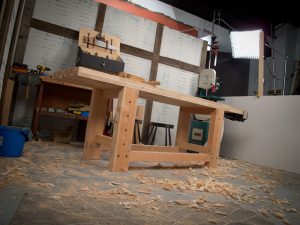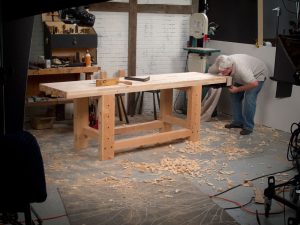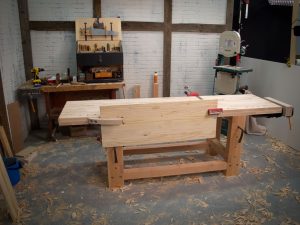We may receive a commission when you use our affiliate links. However, this does not impact our recommendations.
If I told you that shooting a woodworking DVD is hard work you’d probably laugh. It sounds like a supermodel complaining about a photo shoot for the cover of Cosmopolitan magazine.
So I won’t tell you how we worked under hot lights with no air conditioning (the microphones pick up the fan noise), or that the heat cooked my brain until I did some very foul things with a half-made crochet. At least, I think that part was real.
Today about 4 p.m. we wrapped up the shoot for the “Two-day Workbench,” a no-compromises workbench you can build with a few tools, common home center materials and two days of shop time. I wish we could have gone a little longer because I wasn’t able to bring up the fit and finish of the bench to where I like it.
One back leg is proud of the benchtop by a smidge. The crochet needs to be cleaned up. I need to cut the square ovolo shape on the wooden vise chop.
And then there is the small issue of the benchtop.
To make the benchtop, I laminated together two 1-1/2”-thick layers of beech countertop from Ikea.
The lamination went well. But when I went to check the benchtop for flatness with a jointer plane and feeler gauges, there was an area about 6” x 12” that was very low – about 25 thou or so.
That is a “big dipper” when it comes to handwork. In my experience, I have found that a low spot of as little as 6 thou can make your work spring into the depression, making your handplane mostly useless.
So I started to flatten the top for the camera. After about five diagonal passes over the top, the camera crew started to look at their watches – they had to break down and paint a new set that night.
So I left a small valley in the center of the benchtop. Other than that one depression, the countertop was remarkably flat everywhere else. I probably need to make three or more passes with a jointer plane to finish up the top.
I will definitely use these countertops for other future benches. It’s just too easy and makes a solid top.
Other details: In yesterday’s blog entry I pooped on using wet Douglas fir as a workbench material. I want to emphasize that I was talking about wet – 18 percent MC or higher – Doug fir. When it’s dry it is easier to work, but it is still tough stuff and good for a bench.
So if you use wet Doug fir, let it dry a bit in your shop. Don’t be a Schwarz and dive immediately into the project after only one day of buying the material.
The good news is that F+W Media plans to purchase the workbench, so I don’t have to find a customer and I should have the chance to tidy up the bench in the coming weeks before they put it to use.
Tomorrow I head back into finishing another workbench project, but it is one for me: a French oak bench built from ancient timbers.
— Christopher Schwarz
P.S. F+W is shooting for a mid-October release of this DVD.
Here are some supplies and tools we find essential in our everyday work around the shop. We may receive a commission from sales referred by our links; however, we have carefully selected these products for their usefulness and quality.











Hello Christopher … I’m in the process of building this bench … superb teaching job on your part : ) and I’m wondering what brand/model vise did you use on your bench? Also, are there any links you can point me to to help me make a decision as to what I should buy?
Thanks.
Is the DVD you’re talking about out? I’m new on this community and will like to learn more on how to get helpful resources! http://www.woodworkingbank.com
Christopher said on a TV show that he never saw a tail vise that did not eventually sag.
I am getting ready to purchase a Lie Nielson Roubo Bench and I need to know if the tail vise is going to sag?
I’m building a Scandinavian bench (technically, have been for about 5 years now) . I purchased one of the wider Ikea beech tops and ripped it in half length wise to make my stack for the top. One think I’ve been puzzling over, when I glue up the stack, should I line up the joints that make up the lamentations for the top and bottom piece or overlap them so none of the top and bottom glue lines lineup? Seems like not lining up the seams would make each layer aid the other in keeping its seams together…
Chris or Megan,
Do you know if this is still on track for mid-October release?
I am really looking forward to it…
Thanks!
Hi Chris
Have you ever thought about making a standalone crochet with a ‘tail’ that could be held in a leg vice? That way you could temporarily add crochet functionality to a normal bench whenever you need it? Or is that a stupid idea?!
So, Chris, you built a workbench in two days and there are parts of the bench that you wish you had more time with. Hmm. Sounds like an “expectation managment” issue, not a woodworking issue. This from a guy who’s spent hours and hours and hours refabbing a flea market find and returning a “junk bucket resident” to the world of woodworking. Seems to me if a guy needs to have his bench done in two days, he’d be better off buying one already made and spending the time working the project that’s pushing him to have the bench done in two days! LOL All kidding aside, Chris, just wanted to let you know how much I appreciate your entertaining demeanor and the knowledge I’ve gleaned from your endeavors. I recently built a bench myself, having read your book, “Workbenches,” for reference. It enabled me to construct a usable bench for use in the “toy hauler” part of my fifth wheel toy hauler. Thanks for that.
“Stop to smell the sawdust!”
kdh
Hello,
I’ve been slowly planning out my next workbench after reading three of your books.
The IKEA counter tops ended up my top of choice a few months back, but I have yet to get started.
What I wanted to ask was what is the best method to attach the legs/frame to this particular top and is it any different than what you used on this 2-day project?
Also, from your books it seems that almost anything will do for a worktop, and the IKEA counter tops come in 3 varieties, yet you still chose Beech; is that a familiarity with the material, an excuse to use it because its cheaper(ish) to get it in this form, or just pure habit?
Sears/Craftsman sells a “Butcher Block” benchtop. Comes in either 6′ or 8′ length, 24″ deep and 1.5″ thick. APPEARS to be similar to the Ikea product, but I’ve never actually laid eyes on it. The 6′ is currently $110 and the 8′ is $135. Free “site-to-store” shipping for those of use with a local Sears store.
I’m thinking of grabbing a 6′ and gluing onto a piece of MDF or a solid core door from the local restore.
Bench top made from Ikea pieces?
Go wash your hands !…:)
For those in the Northern California area, consider Perfect Plank. They sell a 24 x 96 x 2-7/8″ laminated top for $337 from their shop in Oroville, CA, made from Big Leaf Maple. Not quite as hard as the Birch, but as hard as Southern Yellow Pine. They do ship, but I don’t know the costs.
This is a great bench build. I picked up some good ideas for the base.
The reason for the post though, is I wanted to share my bench top score. My day job is in construction and one of my current projects is a remodel of an old shopping center. So when a 60 foot long, 5 inch by 27 inch glue laminated beam was removed from the building to be replaced by a steel beam, I went home with about 15 feet of the beam. There is enough there for a long bench and a short bench.
Be beam is doug fir. They are not the prettiest, but after cleaning and flattening, I think it will make a great bench top. An 8 foot bench top will weigh in at 250 pounds.
The best part is the top is free. So if anyone sees a construction site where there is activity like I described, stop by and see it you can salvage a piece of an old beam. They just go into the dumpster; a real shame.
This has probably been said before. But its interesting to see the different thoughts about woodworking. There are those that would trade speed/experience for cost. For an example, it took me a long time (about 8 calender months) to build my Roubo-style bench out of 2×10/12 SYP. Total cost for wood was about $100. (spent more on vise screws, than wood) But the experience of trying to match massive mortice/tenons, drawboring, fitting vices, flattening, sharpening, etc. using various power tools and handtools and the time I spent with my father getting the top glued up is priceless. My previous workbench was double 3/4 MDF core (flat for sure) wrapped with 1 1/2″ pine . The workbench looked like a trestle table, it took my a weekend to build, fast yes, but I only learned about 25% of what I learned on the big workbench. Now as a move forward building “house” furniture, I am more confident/faster about many things woodworking than before. Experience vs. cost. We all do it all the time, its neat to see the thought process.
“Don’t be a Schwarz”
Are we going to be making that a thing now?
Dude, don’t be a Schwarz!
Don’t Schwarz up that bench, bro.
;D
Jennie here
I like pine for bench top. Except yellow. Too slick.
I go to a seller wih a big pile of 2 x 4s and pick the straight ones..
Cheap
Let them dry in the shop if necessary.Glue the wide faces together.
Then all threaded them. Probably not necessary.
Pine is easy to level and workpiece doesn’t slide around.
I put a 6″ deep facing on the front of the bench.
Here I use yellow pine
Bore small holes in it and jam in a drawbore pin or scratch awl.
This suppoerts the free end of the great majority of stock held in the crochet.
You always have a pin or awl at hand.
The price is right.
Jennie
Hi Chiris,
Very nice bench. I do have a question about the top. Did you have to prep the countertops prior to laminating them, ie remove the finish or perform some flattening on the glue side or, did you just use a glue that will bond to anything and go just go for it?
Thanks.
Chris, I have been thinking of using a Grizzly 72″ x 24″ x 2¼” Rock Maple Butcher Block which is $400 delivered to me. Two IKEA tops would cost me $407 delivered. If you were to do this project again, would you choose the 2¼” Grizzly Maple or the 3″ IKEA beech lamination?
Nice work Mr, Schwarz. You are a bench building power animal.
Not my power animal, unfortunately. That an honor already reserved for a dyslexic chipmunk.
For those of you interested in the countertops, here’s the link to IKEA:
http://www.ikea.com/us/en/catalog/products/20057854/
Albert